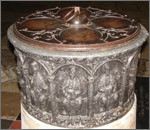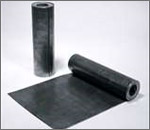Lead is rarely found by itself, but rather is usually a by-product of the processing of other ores. It is also the final stage of radioactive decay of some unstable metals, such as uranium orradium

.
Dull gray in color, lead is quite soft. For example, in an account of her father's hunting in the mid-1800s, Waheenee, a Hidatsa woman, remarks that, "For shot he used slugs, bits of lead which he cut from a bar, and chewed to make round like bullets. Powder and shot were hard to get in those days." (Wahenee 1927:18) Lead also has a low melting point, which makes it a ready alloy with other metals, as well as a good metal for casting artifacts at comparatively low temperatures. In addition, lead is quite heavy, so that it is well used in weights. Thus archaeologically we find lead artifacts from quite early times.
Metals, like tin, were (and are) sometimes combined with silica in ceramic glazes, to which they lend a hard, shiny surface, the color of which can be controlled by the combination ofmaterials. However most metals have a melting point above the capacity of the ancient kilns (or in some cases simple dung fires) used in ceramic manufacture. An admixture of lead could create alloys with amelting point within the range of relatively low-temperature ceramic production. When higher temperatures were available, lead still often increased the flexibility of the glaze as well as its lustre. For this reason, lead has long been associated with the production of spectacular pottery glazes and porcelain ware.
Lead suspended in paint can also help to produce a hard, usually shiny, long-lasting surface.

Lead is a toxin, which builds up gradually in the body until it hits a threshold amount and begins to produce symptoms. Unfortunately, the effect is gradual enough that for many centuries what we now know to be lead poisoning was not associated specifically with lead. Gradual lead poisoning can result from water carried through lead pipes such as those sometimes used in ancient Rome, for example, or from wine served from lead vessels, although the toxicity is apparently considerably less (unto negligible) in most alloyed forms.
Because lead has been used as an ingredient in ceramic glazes, it has proven a source of potential poisoning to users of ceramics fired at low temperatures. Some foods, such as orangejuice, interact with lead glazes to draw the lead into food especially quickly. For this reason lead is now normally excluded from ceramic glazes by most potters, and those who do make use of it confine it to external decoration of objects not intended to contain foods.


